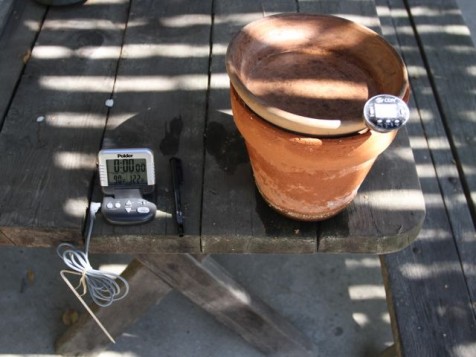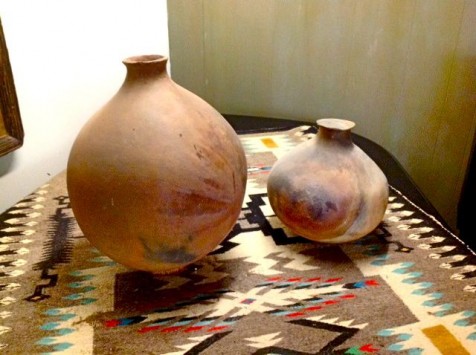
Maybe it was the furnace heat of California last month, or the topicality of NASA’s Curiosity landing, but here I am having my first – and almost certainly last – von Däniken moment.
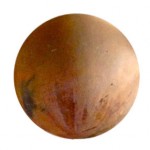

How else though, aside from some ancient Martian visitation, could Native Americans of centuries past, without the benefit of telescopes or interplanetary probes, design water pots so closely matching the Red Planet?
Well, on reflection, I guess a mixture of clay and cactus juice might just bake out that way in the sun.
Which brings us to the real science behind these earthenware pots. Because although they may well be over two hundred years old, discovered in 1926 by my wife’s geologist great-grandfather in the desert of San Diego County, these water carrying olla represent nothing less than the world’s first refrigerator.

The water inside the olla reaches a temperature substantially below that of the surroundings thanks to the principle of evaporative cooling – something you can demonstrate to yourself just by licking a finger and waving it around. The skin feels cooler because the heat needed to turn liquid water molecules in your spit into vapourised water molecules leaving your hand is taken from your skin. The amount of heat, or energy, needed to change from a liquid to a gas is called the latent heat of evaporation, which for water is 2257 kJoules per kilogram.

The sun-baked porous clay of the olla acts like a wick, delivering a constant flow of evaporating water to the surface where it quickly evaporates, cooling first the surface and in turn the water inside the pot.
Wondering how effective ollas really are, but with live tests on our delicate pots off the agenda, I turned to theoretical musings and some (not entirely successful) experimentation.
The Theory
The temperature on the pot’s surface, or wet-bulb temperature, is easy enough to calculate if we know the ambient air temperature, relative humidity (how much water is already in it), and local air pressure – as that affects the dew-point temperature at which water changes from liquid to gas. I got all that info from my local weather station online, and plugged it into one of the many online calculators – like this one at the National Oceanic and Atmospheric Administration (NOAA) – to find the wet bulb temperature. (The exact calculation is complex and explained on the NOAA website, but essentially the drier the air, the lower the wet-bulb temperature; water molecules already in the air decrease the net evaporation rate.)
The day I looked at this, the values were: temperature 34 C, relative humidity 20%, and air pressure 1014.9 millibars, for which the NOAA calculator returned a wet-bulb temperature of about 19 C. That’s a whole 15 degrees below ambient temperature; modern electric fridges don’t do much better than that (okay – granted they can get to lower absolute temperatures).
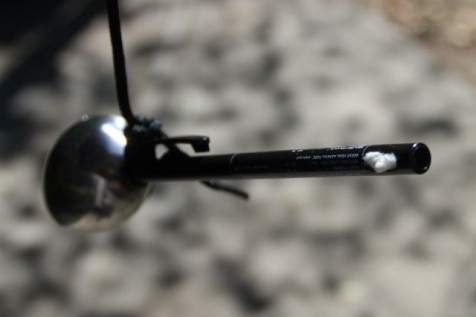
The wet-bulb temperature I verified experimentally using a cooking thermometer modified with wet paper-towel stuffed in around the sensor tip (a mercury thermometer would have a bulb of mercury at the end – hence wet-bulb; but this was all I had and works well enough). Swinging the thing fast round my head on the end of a shoelace simulated wind and, lo and behold, I recorded a wet-bulb temperature of 21C. Not quite the predicted 19C, but in the right area.
Good ventilation of the olla is necessary as it influences the evaporation rate, and the area for evaporation should be large (the olla’s spherical design is fantastic in this regard as it maximises the area). The area of non-wetted contact should be small to minimise absorption of heat by conduction from the surroundings – here again, the point contact of the spherical olla is perfect. Ollas also work better in the shade, to minimise heating by solar radiation.
Calculating how long the contents take to cool is more tricky, requiring an estimate of the evaporation rate from a porous surface. But we can get some handle on it using an assumed rate of 7kg/m2.day (based on some data I found for swimming pool evaporation rates in Australia of all things), latent heat of evaporation of water 2257 kJ/kg, and heat capacity of water 4.18 kJ/kg.K. From which I reckon the 0.3m diameter olla, holding 14 litres (=14 kg) of water, needs to lose 878 kJ of heat to fall in temperature by 15 degrees, equal to evaporating 0.4 litres (0.4kg or 3% of the contents) from the 0.28 m2 surface over a 5 hour period.
The numbers aren’t perfect, but suggest in its heyday our olla was up and usefully cooling in a couple of hours.
The Practise
Now for the not-totally-successful experimentation part of the post.

You can see what I’m trying to do here: my very own plant pot olla. The physical conditions (temp.,humidity,pressure) were the same as the theoretical calculation; and I’d confirmed a wet-bulb temperature of 22C as described above. The pot was kind of working too; that dark band in the middle and top is water seeping through the porous terracotta – and it was pretty consistent throughout the experiment.
Stirring the contents and taking regular measurements indicated a one degree fall over the first two hours. But then the temperature started to climb again, which suggests the pot was just not porous enough over sufficient area to counter heating by conduction through the non-wetted areas. A lack of wind won’t have helped – maybe use a fan next time. At least no one can accuse me of selectively publishing only positive results.
Other Coolers
The Arab Zeer works in a similar fashion to the olla, but consists of two pots separated by wet sand. Fruit and other perishables can be kept fresh in the central pot.
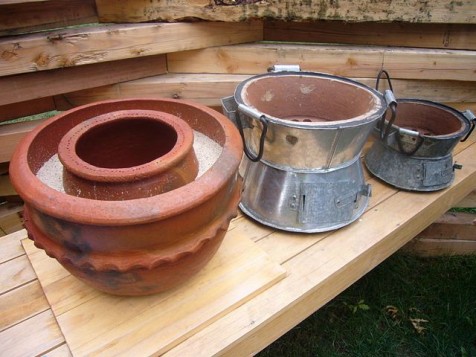
A modern invention is this Terracooler: an evaporatively cooled terracotta bell-jar placed over food to keep it fresh.
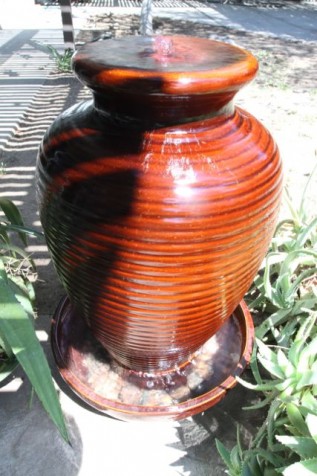
And keep an eye out for artificial waterfalls used to create a cool atmosphere in public spaces, or the same principle operating in simple garden water features: the water in this one I measured at 24C on a 32C day.
I’m back in the UK now, where typical humidity levels close to 100% (=rain) preclude the extensive program of further evaporative cooling tests this discussion clearly signposts. If you have more luck with your own ollas though, do let me know.
